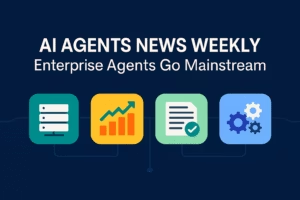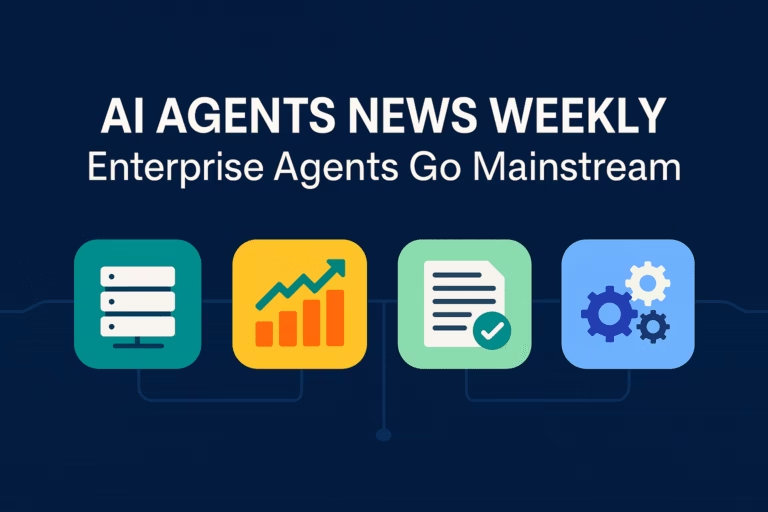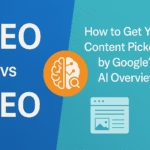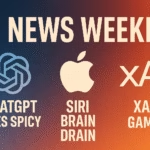Key Takeaways
- •
Enterprise AI agents have moved from pilot projects to production, delivering measurable ROI. - •
BigID’s MCP server creates a secure highway between AI agents and corporate data systems. - •
Workday, Oracle, and PostNL are already reporting six and seven figure returns from agent automation. - •
Data readiness, not budget, remains the single biggest blocker for enterprise AI scalability. - •
Interoperability between agents is becoming the new competitive edge across industries.
This week in AI agents news, we officially crossed from theory to reality.
Enterprises aren’t experimenting anymore – they’re deploying.
The numbers rolling out from Workday, Oracle, and PostNL prove what many predicted: agentic AI is becoming the default operating layer for serious businesses. What used to be pilot projects are now full-scale production systems saving thousands of hours and millions in costs.
The wave is accelerating because of one thing: infrastructure maturity. From BigID’s secure MCP servers connecting agents to enterprise data, to Oracle’s specialized finance agents, to Salesforce and Anthropic’s deep partnership, the groundwork for trustworthy enterprise automation is here.
If you’re still wondering whether this is hype or history, take note – this week’s results are measured in real ROI, not press releases.
💡 Curious which enterprise-grade agents are gaining traction? Explore verified listings and comparisons on AI Agent Store.

The MCP Server Revolution – Connecting Agents to Enterprise Data
Every enterprise wanted autonomous agents. Few could give them safe access to sensitive data.
That changed this week.
BigID released the first Model Context Protocol (MCP) server purpose-built for enterprise systems, finally solving the trust gap between agent autonomy and data security. Think of it as a verified highway for AI. Agents can now fetch and process internal information without bypassing governance or compliance rules.
For developers, this is the missing infrastructure piece that makes scalable agent deployment possible. They can now give AI agents precise, real-time access to company data – financial, HR, operational – while enforcing permissions and audit trails.
For business leaders, this is massive. It means automation can go beyond chat interfaces and analytics dashboards. Agents can now act on real business data, trigger workflows, and maintain compliance in one motion.
This shift turns AI agents from helpful assistants into trusted operational layers inside the enterprise. It’s what cloud was to storage, or APIs were to software. A silent revolution in how machines communicate safely.
Real ROI Numbers from Production Deployments
The AI agent market finally has receipts.
Workday shared tangible outcomes from deployed agents that would make any CFO smile. Contract execution time fell by 65%. Personnel change processes dropped 90%. Teams reclaimed 900+ hours annually through automated audits. Even payroll cycles now run four times faster.
General Motors, one of Workday’s early enterprise adopters, reported a 70% reduction in candidate screening time with its Recruiter Agent, transforming how talent pipelines operate at scale.
For years, executives demanded proof that agent automation wasn’t just a tech experiment. This week delivered it. These numbers represent production deployments, not pilots.
For smaller firms, this data should serve as a reality check. Enterprises are quantifying the savings, not guessing. AI agents are no longer a “future investment.” They’re measurable infrastructure delivering operational gains right now.
And for developers building the next generation of these systems – the message is clear. The winners will be those who blend secure data access, auditable workflows, and real-time action into one seamless agent experience.
Oracle Expands Agent Portfolio for Finance Teams
Oracle made a bold statement this week: finance doesn’t need more dashboards; it needs more agents.
They rolled out four new AI agents embedded directly into Fusion Cloud Applications, each aimed at eliminating bottlenecks that accountants and CFOs have quietly lived with for decades.
The Payables Agent automates invoice processing across multiple channels – email, portals, EDI, even PDFs. It extracts data, checks taxes, matches purchase orders, and routes approvals automatically.
The Ledger Agent monitors journal entries, identifies anomalies, and creates adjustment journals before accountants even open a spreadsheet.
The Planning Agent turns real-time data into rolling forecasts and event-driven predictions.
The Payments Agent optimizes outgoing cash flow and manages early payment discounts.
And for the builders behind the curtain, Oracle added AI Agent Studio, giving developers the tools to create and customize their own Fusion-native agents.
This update shows how fast traditional enterprise systems are being reimagined. The agents are not features tacked on top – they’re woven into core financial architecture.
The result? Accountants move from record-keeping to strategy, and CFOs finally get the continuous insight every finance department has been chasing for years.
The Data Readiness Gap – Why AI Budgets Aren’t Scaling
Here’s the uncomfortable truth behind most AI programs: budgets are rising, but outcomes aren’t.
Qlik’s 2025 Agentic AI Study exposed why. Across industries, data readiness – not ambition or investment – is the main obstacle stopping enterprise AI from scaling.
The message is blunt. You can’t automate what you don’t understand, and most organizations still have data spread across silos, shadow systems, and legacy servers.
For technical teams, this isn’t just a side project; it’s the foundation. Before any AI agent can make decisions or automate workflows, it needs structured, accessible, and governed data.
For executives, this explains why AI initiatives stall after exciting press releases. Without the groundwork, agents become expensive prototypes that never graduate to production.
The fix isn’t glamorous. It involves data engineering, schema alignment, and governance frameworks that make information trustworthy. But once the plumbing works, the payoff compounds fast – as Workday, Oracle, and PostNL have already proven.
Document Intelligence Gets $75M Boost
If paperwork were a person, it would be the most overworked employee in every company.
That’s exactly why Reducto just raised $75 million in Series B funding to scale its AI-driven document intelligence platform.
The goal is simple: let AI read, extract, and validate every contract, invoice, and compliance report automatically. For enterprises drowning in PDFs, this means liberation from repetitive data-entry hell.
Reducto’s technology doesn’t just scan documents; it interprets them. It understands clauses, compares terms, flags missing signatures, and ensures compliance with internal policies.
In industries like banking, insurance, or logistics, this isn’t convenience – it’s survival.
For developers, Reducto’s progress signals a wider opportunity. As agents gain the ability to reason over text-heavy data, whole departments can be automated end to end.
For business leaders, this shows the maturation of agentic AI in one of the hardest areas to crack: unstructured information.
Document intelligence has quietly become the backbone of scalable automation. When your data starts explaining itself, your agents can finally act without human babysitting.
Salesforce and Anthropic Deepen Enterprise AI Partnership
This week, two heavyweights in enterprise AI decided to tighten their grip on the future. Salesforce and Anthropic announced an expanded partnership to integrate Claude AI across the Salesforce ecosystem – from Service Cloud to Einstein 1 Platform.
The focus is on trust, transparency, and responsible deployment. In plain English, that means agents that talk to customers are finally being treated with the same care as those handling back-end data.
The integration enables sales and support teams to build agents that respond with verified data while logging every decision. It also introduces new safety layers, ensuring agents can explain their actions and adhere to compliance standards.
For businesses, this addresses the biggest lingering fear about AI automation: accountability. If an agent makes a mistake, who’s responsible? With Salesforce’s structure and Anthropic’s guardrails, that answer is finally clear – the system itself.
This partnership isn’t about hype. It’s about making enterprise AI trustworthy enough to operate in customer-facing roles without the brand risk that usually follows untested automation.
The new competitive advantage isn’t just having smart agents; it’s having reliable ones.
PostNL Case Study – SDLC Automation Delivers Million Dollar Savings
PostNL quietly showed the world what real agentic automation looks like in production.
Using EPAM’s AI/Run model, the logistics giant deployed over 20 agents across the entire software development lifecycle.
The results were nothing short of radical.
Manual test case creation time dropped by 80 percent.
User story generation became 75 percent faster.
Manual documentation work fell by 90 percent.
Each agent handled a different stage of the SDLC, from code review to documentation and testing. Together, they worked as a coordinated system, not isolated bots.
For developers, this is a masterclass in modular automation. You don’t build one huge agent to run everything. You build several small, specialized ones that talk to each other and scale effortlessly.
For business leaders, the payoff is already clear. The client mentioned in the case study recorded 1.7 million dollars in net benefits and a 30 percent shorter development cycle in just one year.
This isn’t theoretical ROI. It’s a working template for how multi agent orchestration can unlock both technical and financial gains.
Healthcare Gets Agentic AI Platform for Patient Experience
Healthcare usually lags behind in digital transformation, but SoundHound AI just shifted the narrative.
At HLTH 2025, the company unveiled the Amelia AI Agent platform, built specifically to streamline patient interactions and administrative workflows.
The system can handle complex, multi intent conversations like rescheduling appointments, reporting symptoms, checking benefits, or requesting prescription refills in one seamless dialogue. It connects to existing healthcare systems securely while protecting patient data.
A separate Member Benefits Agent helps patients compare coverage options, verify costs, and track claims without waiting for human staff.
For hospitals and insurance providers, this is a glimpse of the near future: one agent managing dozens of patient service tasks simultaneously, with compliance built in.
For newcomers, this is what agentic AI actually means in practice. The model recognizes intent, takes the right actions, and follows through across systems. It doesn’t just answer questions. It gets work done.
The healthcare sector’s adoption signals a broader truth: any process that relies on structured conversations and record updates is now fair game for automation.
Scientific Discovery Platform Embraces AI Interoperability
Wiley, one of the oldest names in research, quietly launched something far more futuristic: a scientific discovery platform designed for interoperability with leading AI systems.
For decades, research data lived in silos, locked behind subscriptions or incompatible software. Wiley’s new model changes that. It allows researchers to connect directly to AI tools that analyze data, detect correlations, and even propose new hypotheses.
This means scientists can now collaborate with AI in real time, using shared context instead of exporting endless CSV files or PDFs. It’s the foundation for what some analysts are calling “networked discovery” – where multiple AI systems work together rather than compete for isolated tasks.
For technical teams, the concept mirrors what’s happening in the enterprise world. Agents that can talk to each other, share memory, and operate under consistent protocols are more powerful than standalone tools. For businesses, it hints at a future where interoperability, not scale, becomes the true advantage.
When agents can collaborate across departments, clouds, and contexts, progress compounds automatically.
Final Analysis – The Enterprise Agent Era Has Begun
The week’s AI agents news didn’t just reveal new tools. It showed the start of an enterprise transformation cycle that will define the next decade.
BigID solved the security puzzle. Workday proved ROI. Oracle redefined finance workflows. Salesforce and Anthropic brought accountability to the front lines. PostNL automated the developer’s desk. And SoundHound AI bridged the human gap in healthcare.
Every story points to the same truth: autonomous systems are finally earning their place in serious business operations. The hype phase is over. The deployment phase has begun.
For leaders, the takeaway is to stop waiting for perfect conditions. For developers, it’s to start designing with interoperability and compliance in mind. And for newcomers, it’s to understand that the next wave of innovation will be built not on single models, but on networks of cooperating agents.


